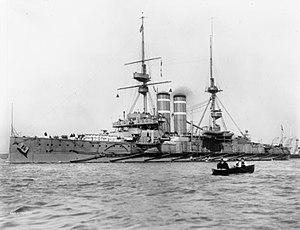 HMS Hindustan
| |
| History | |
|---|---|
| Name | HMS Hindustan |
| Namesake | Hindustan |
| Builder | John Brown & Company, Clydebank |
| Laid down | 25 October 1902 |
| Launched | 19 December 1903 |
| Completed | March 1905 |
| Commissioned | 22 August 1905 |
| Decommissioned | 15 May 1918 |
| Fate | Sold for scrapping 9 May 1921 |
| General characteristics | |
| Class and type | King Edward VII-class pre-dreadnought battleship |
| Displacement | |
| Length | 453 ft 9 in (138.3 m) (loa) |
| Beam | 75 ft (22.9 m) |
| Draught | 25 ft 8 in (7.82 m) |
| Installed power |
|
| Propulsion | |
| Speed | 18.5 knots (34.3 km/h; 21.3 mph) |
| Complement | 777 |
| Armament |
|
| Armour | |
HMS Hindustan was a King Edward VII-class pre-dreadnought battleship of the Royal Navy. Like all ships of the class (apart from HMS King Edward VII) she was named after an important part of the British Empire, namely the Indian Empire. The ship was built by John Brown & Company; she was laid down in October 1902, was launched in December 1903, and was completed in March 1905. Armed with a battery of four 12-inch (305 mm) and four 9.2 in (234 mm) guns, she and her sister ships marked a significant advance in offensive power compared to earlier British battleship designs that did not carry the 9.2 in guns.
Hindustan was commissioned in August 1905 for service with the Atlantic Fleet, moving to the Channel Fleet in 1907. When the latter fleet was reorganised to the Home Fleet in 1909, she was attached to that fleet. In 1912, Hindustan and her sister ships formed the 3rd Battle Squadron; that year, the squadron went to the Mediterranean Sea during the First Balkan War as part of an international blockade of Montenegro. In 1913, she returned to British waters.
The squadron was assigned to the Grand Fleet at the beginning of the First World War, and served on the Northern Patrol. Through 1914 and 1915, the ships frequently went to sea to search for German vessels, but Hindustan saw no action during this period. By the end of the year, the Grand Fleet stopped operating with the older 3rd Battle Squadron ships, and in 1916, the squadron was transferred to Nore Command. Hindustan served there until she was detached in February 1918 to serve as a depot ship for the raids on Zeebrugge and Ostend. Decommissioned in May 1918, she finished the war as a barracks ship, and was broken up in 1923.